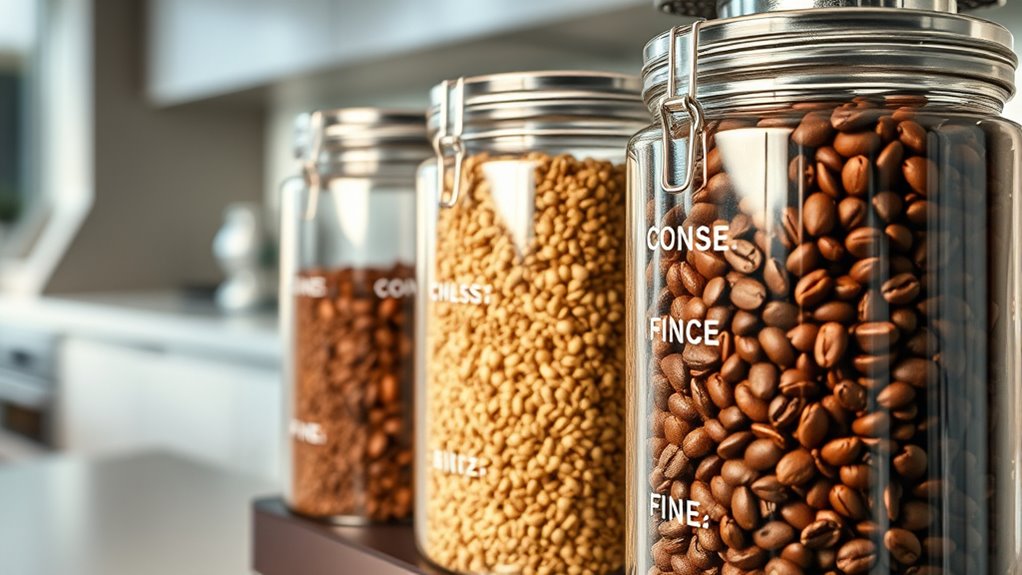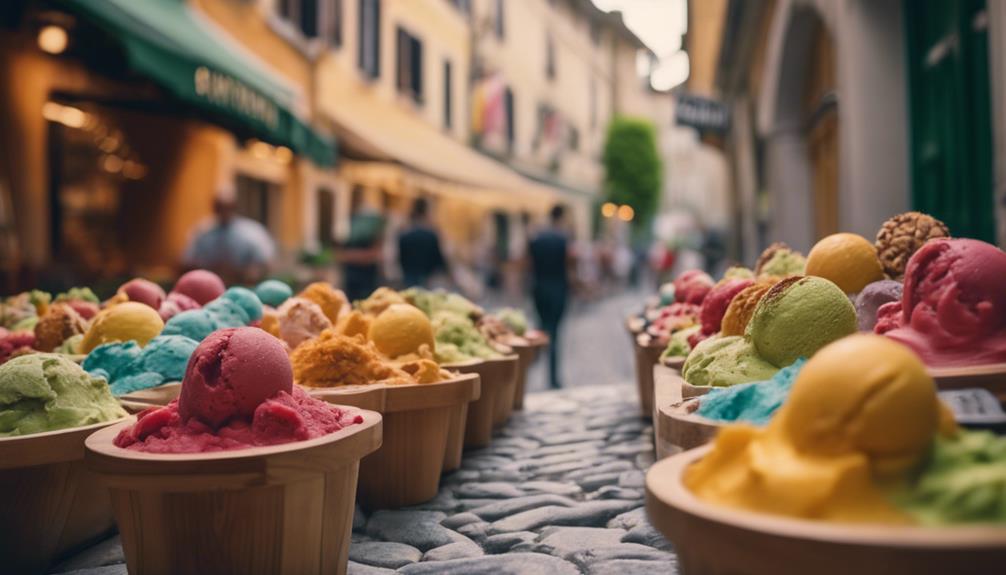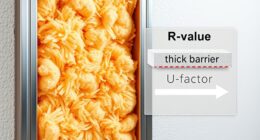Many beginners rely solely on visual cues or fixed grind settings, which can lead to inconsistent extraction. Using the same grind for different beans, roasts, or equipment can cause weak or bitter coffee. Failing to calibrate your grinder regularly or adjust based on brew time and taste can ruin your results. Understanding the grind size scale and how it varies across brands helps, but if you keep these mistakes in mind, you’ll improve your brewing—more tips follow.
Key Takeaways
- Relying solely on visual cues or inconsistent measurement methods leads to inaccurate grind size assessments; use calibration tools for precision.
- Ignoring specific brewing method and equipment requirements causes improper extraction; match grind size to your brewing technique.
- Not adjusting grind size based on extraction taste, time, or batch volume results in weak or over-extracted coffee; regularly taste and tweak.
- Skipping grinder calibration and maintenance creates uneven particle sizes, affecting flavor consistency; calibrate frequently and clean regularly.
- Applying a fixed grind setting across different beans, roasts, or equipment leads to poor results; tailor grind size to each variable.
Relying Solely on Visual Cues Rather Than Actual Grind Measurements
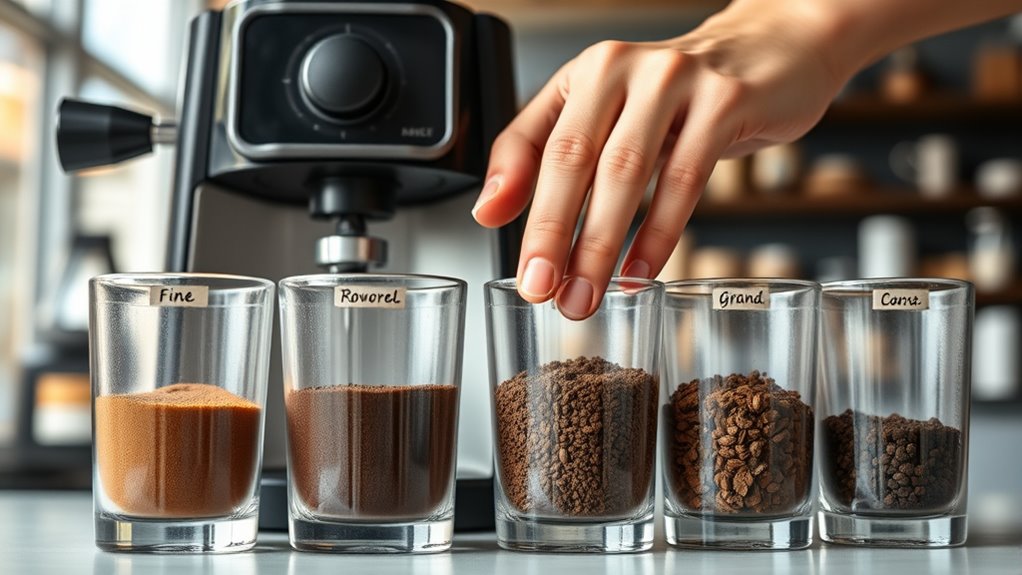
Relying solely on visual cues to judge grind size can lead to inconsistent results because appearance doesn’t always reflect the actual particle size. Visual assessment may seem quick and easy, but it often misleads you about the true grind consistency. For example, a grind that looks fine might actually have uneven particles, affecting extraction and flavor. To improve accuracy, you should make manual adjustments based on the results of your brewing. Tweak the grind size incrementally and test again, rather than relying solely on how it looks. This hands-on approach helps you get closer to the ideal grind for your equipment and beans. Remember, a precise grind isn’t just about appearance; it’s about how it performs during brewing. Incorporating grain size analysis methods can further refine your process and ensure more consistent results.
Ignoring the Specific Brewing Method’s Ideal Grind Size
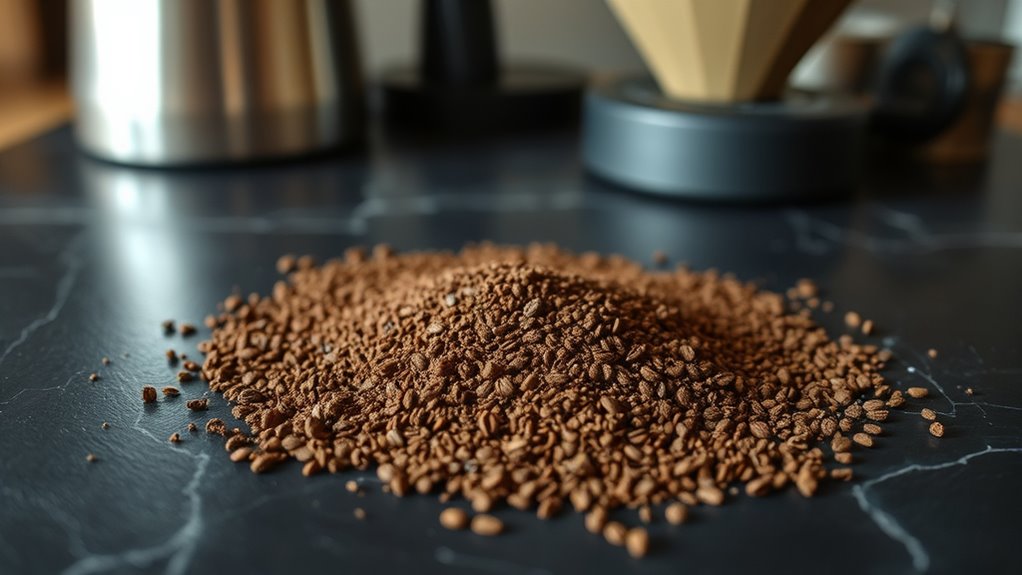
Ignoring the ideal grind size for your specific brewing method can substantially compromise your coffee’s flavor and extraction. Different brewing methods require varying grind sizes for excellent results. For example, espresso demands a fine grind for quick extraction, while French press needs a coarse grind for a slow brew. Using the wrong size affects grind consistency and can lead to over or under-extraction. Visual cues alone aren’t enough; understanding your brewing method guides your grind choices. Properly matching brew time to your grind size is essential for optimal extraction and flavor.
| Brewing Method | Perfect Grind Size |
|---|---|
| Espresso | Very fine |
| AeroPress | Fine to medium |
| Pour-over | Medium |
| French press | Coarse |
| Cold brew | Extra coarse |
Pay attention to your specific method to perfect your coffee every time.
Using the Same Grind Setting for Different Beans or Roast Levels
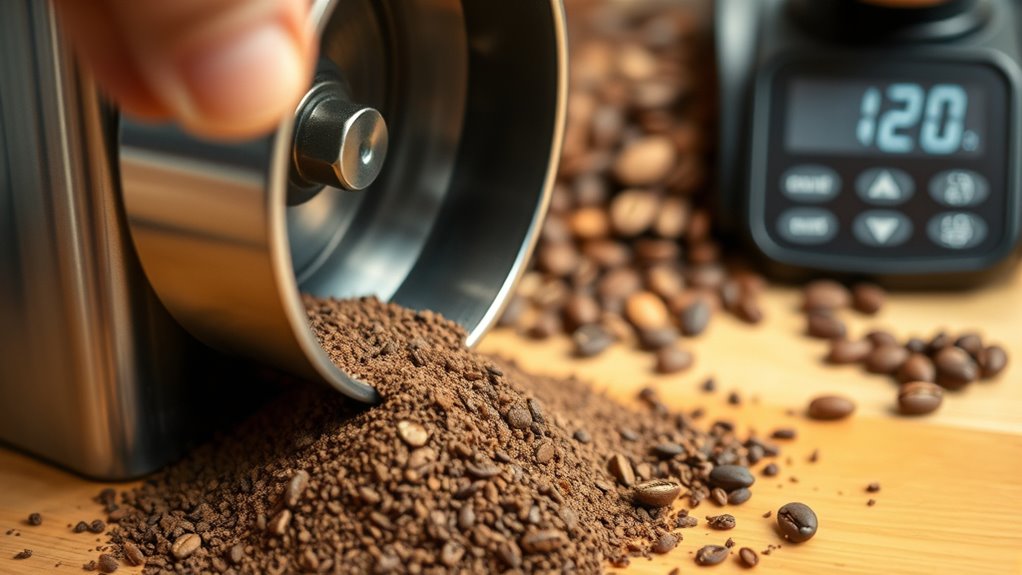
Using the same grind setting for different beans or roast levels can undermine your coffee’s flavor and extraction. Freshness and roast level considerably affect how beans respond to grind size. For example:
Vary your grind size to match bean freshness and roast level for optimal flavor and extraction.
- Fresher beans often need a slightly finer grind to extract their full flavor.
- Dark roasts generally require a coarser grind because they’ve already released more oils and flavors.
- Lighter roasts benefit from a finer grind to balance extraction.
- Old or stale beans might need a coarser grind to avoid over-extraction and bitterness.
- Grind size adjustments can also influence the consistency of your brew, ensuring an even extraction throughout.
Ignoring these differences can lead to weak, bitter, or uneven brews. Adjusting your grind based on bean freshness and roast level guarantees ideal flavor, extraction, and consistency every time.
Not Adjusting Grind Size Based on Extraction Time and Taste Results

If your coffee tastes flat or over-extracted, your grind size might need adjusting. You should also watch the extraction time to see if it aligns with your desired brew. Tasting regularly helps you fine-tune the grind for consistent, clear results. For those using high-performance equipment, understanding how tuning kits can optimize your setup may also be beneficial.
Tasting for Clarity
While tasting your coffee for clarity, it’s tempting to rely solely on initial impressions without adjusting the grind size. To truly assess flavor profiling and aroma enhancement, focus on these steps:
- Notice if the coffee’s flavor is muddled or overly flat; this indicates a need to refine the grind.
- Identify if the aroma lacks vibrancy; a sharper grind can improve aroma release.
- Detect any sour or bitter notes that may suggest over or under-extraction, guiding you to tweak grind size accordingly.
- Evaluate the overall balance—clarity in taste helps you determine if the grind results in a clean, well-defined cup.
- Ensure your grind size aligns with your brewing method; using the correct headphone jack type can facilitate better equipment setup and calibration.
Time and Consistency
Consistently adjusting your grind size based on extraction time and taste results is key to brewing a balanced cup. If your brew time varies, it indicates inconsistent grind consistency, which can lead to over- or under-extraction. Instead of changing your grind size sporadically, monitor your brew time regularly and stick to a set grind size until you notice a pattern. When your brew time is too short, grind a little finer; if it’s too long, coarsen the grind. This disciplined approach helps develop a steady grind consistency, making it easier to fine-tune your process over time. By paying close attention to both brew time and taste, you’ll improve your overall consistency and create more predictable, flavorful coffee every time. Additionally, maintaining uniform grind size ensures your brewing process remains reliable and consistent.
Confusing Grind Size Terms Across Brands and Equipment

Confusing grind size terms across brands and equipment is a common source of frustration for coffee enthusiasts. Different manufacturers often use varying grind size terminology and equipment specific labels, making it hard to find the right setting. To navigate this, keep these points in mind:
- Recognize that “medium” may differ between brands and grinders.
- Check for equipment specific labels like “burr grinder,” “blade grinder,” or “espresso grind.”
- Use visual guides or comparison charts to match grind sizes across brands.
- Understand that grind size terminology isn’t universal—what’s called “coarse” in one brand could be “French press” in another.
- Familiarizing yourself with asset division principles can help you better understand how grind size choices impact your coffee setup and adjustments.
Overlooking the Impact of Grinder Type and Quality on Consistency
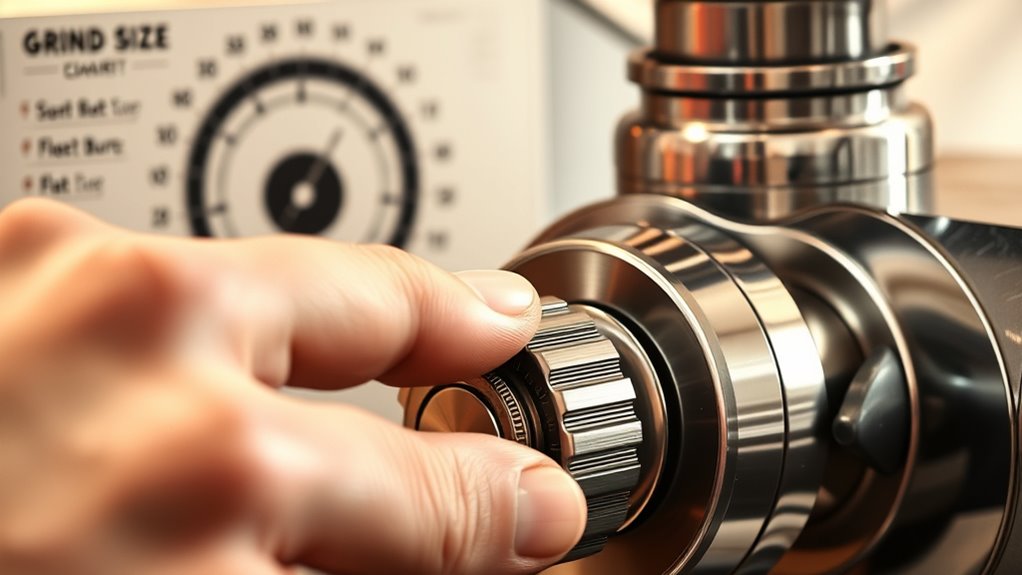
Your choice of grinder type and its quality directly influence the consistency of your coffee grounds. Poor-quality grinders or those not suited to your equipment can lead to uneven grind sizes, affecting extraction and flavor. Grinder calibration is essential; even the best grinder won’t perform well if it’s not properly calibrated for your brewing method. Additionally, equipment compatibility matters—using a grinder incompatible with your coffee maker can cause inconsistent results. Cheaper blade grinders often produce uneven grounds, while burr grinders offer more uniformity but vary in quality. Investing in a high-quality grinder designed for your equipment ensures better consistency, reducing the need for frequent adjustments and helping you achieve a more balanced, flavorful brew every time. Understanding credit card terms is also crucial for managing your expenses effectively and avoiding unexpected charges.
Failing to Calibrate Your Grinder Regularly for Accuracy

Regularly calibrating your grinder is vital for maintaining consistent coffee grounds, but many users overlook this step, leading to uneven extraction and flavor inconsistencies. Proper grinder maintenance, including calibration, ensures you achieve the right grind size every time. To stay on track:
- Set a calibration frequency based on usage—more often if you brew daily.
- Use calibration tools or test batches to verify grind consistency.
- Adjust your grinder immediately if you notice flavor shifts or uneven extraction.
- Keep a maintenance schedule to prevent buildup that can skew grind size accuracy.
- Understanding the importance of Rhythm Failure can help you stay motivated in maintaining your equipment.
Neglecting calibration can cause your grind size to drift, affecting brew quality. Regular calibration is a simple but essential part of grinder maintenance that guarantees your coffee remains flavorful and balanced.
Neglecting to Consider Grind Size When Changing Batch Sizes or Brew Volumes

When you change your batch size or brew volume, it’s crucial to adjust your grind size accordingly; otherwise, you risk undermining your coffee’s flavor and consistency. Batch size adjustments and brew volume variations directly impact extraction time and water flow, meaning your grind size must be tailored to these changes. Using the same grind size for different batch sizes can lead to over- or under-extraction, resulting in weak or bitter coffee. If you’re brewing a larger volume, a slightly coarser grind may be necessary to prevent over-extraction. Conversely, smaller batches might require a finer grind to ensure proper extraction. Ignoring this relationship can compromise your brew quality. Always reassess your grind size whenever you modify batch sizes or brew volumes to maintain essential flavor and consistency.
Misinterpreting the Grind Size Chart’s Numerical Scale Without Understanding Its Context

The numerical scale on grind size charts can be confusing if you don’t understand what it truly represents. Without knowing the context—such as brewing method or grinder type—you risk misinterpreting the numbers. To get consistent results, you need to prioritize understanding the scale’s meaning and how it applies to your setup.
Numerical Scale Explained
Understanding the numerical scale on a grind size chart can be tricky if you don’t know what the numbers actually represent. These numbers typically indicate the size of the coffee grounds, affecting brew time and flavor. However, they don’t directly measure grind consistency or measurement accuracy. To clarify:
- Lower numbers (e.g., 1-4) usually mean coarser grounds, suitable for French press.
- Mid-range numbers (e.g., 5-8) are medium grounds, ideal for drip coffee.
- Higher numbers (e.g., 9-12) are fine grounds, used for espresso.
- The scale is relative; a 6 in one chart might differ from another.
- Understanding the grind size scale helps in achieving the desired brew quality and consistency.
Focusing only on the numbers without understanding their context risks inconsistent grind size, which hampers grind consistency and measurement accuracy.
Context Matters Most
Without grasping the full context of a grind size chart, it’s easy to misinterpret what the numbers really mean. Grind size chemistry varies depending on your brewing method, so a “medium” grind in one setup might be too coarse or fine in another. The numerical scale isn’t universal; it’s relative, reflecting the relationship between grind particles and brewing precision. For example, espresso requires a much finer grind than French press, even if both are labeled “medium.” Understanding this context ensures you select the right grind for your equipment and technique. Without it, you risk inconsistent extractions and subpar coffee. Focus on how the grind interacts with your brewing process, not just the number on the chart. This awareness is key to mastering brewing precision.
Avoiding Scale Confusion
Have you ever looked at a grind size chart and wondered what the numbers truly mean? Misinterpreting these numbers can lead to errors in your brew, often caused by a lack of understanding of scale calibration and measurement accuracy. To avoid scale confusion:
- Confirm the scale’s calibration—not all charts use the same units or reference points.
- Know whether the numbers indicate fineness or coarseness, as this varies between brands.
- Use a consistent grinder and measurement method to ascertain accuracy.
- Cross-reference the chart with your grinder’s settings to prevent misalignment.
Assuming One Fixed Grind Size Is Suitable for All Equipment and Conditions

Many beginners assume that a single grind size works perfectly across all brewing methods, but this isn’t the case. Equipment variations and bean characteristics considerably influence the ideal grind. For example, espresso machines need a fine grind, while French presses require a coarser one. Using the wrong size can lead to under-extraction or over-extraction, ruining your brew.
| Equipment | Bean Characteristics | Recommended Grind Size |
|---|---|---|
| Espresso machine | Dark, oily beans | Fine |
| Pour-over | Light, delicate beans | Medium-fine |
| French press | Coarse, dense beans | Coarse |
| AeroPress | Varies, quick brew | Medium or fine |
Adjust your grind based on equipment and bean type for ideal flavor.
Frequently Asked Questions
How Do I Measure Grind Size Accurately Instead of Just Guessing?
To measure grind size accurately, use a dedicated grind size tool or a scale for consistency. Focus on coffee density, which affects how the grounds feel and behave. Avoid guessing by comparing your grounds to standard references or using a grind size chart. Consistently weigh your coffee grounds and adjust based on brewing method preferences, ensuring your grind size matches the desired extraction and flavor profile for the best results.
Why Does My Brew Taste Different With the Same Grind Setting?
Your brew tastes different with the same grind setting because factors like brew temperature and filter quality modify. If your water’s hotter or cooler, it alters extraction, impacting flavor. Likewise, a high-quality filter guarantees cleaner water, which enhances taste consistency. Even minor variations in these elements can make your brew taste different, so always check your brew temperature and filter quality to maintain a consistent, delicious cup.
Can I Use the Same Grind Size for Espresso and French Press?
Like a painter choosing different brushes for each masterpiece, you shouldn’t use the same grind size for espresso and French press. These brewing methods demand distinct grind size compatibility; espresso needs a fine grind, while French press calls for a coarse one. Equipment considerations are key—using the wrong grind can lead to over-extraction or under-extraction, ruining your brew. Adjust your grind size to match each method for ideal flavor and performance.
How Often Should I Calibrate My Grinder for Consistent Results?
You should calibrate your grinder regularly to maintain grind consistency. For most home brewers, once a month or every 100-150 uses is ideal. If you notice fluctuations in flavor or extraction, increase calibration frequency. Consistent calibration helps guarantee your grind size stays precise, leading to better-tasting coffee. Keep track of your calibration schedule and adjust it based on how often you use your grinder for ideal results.
Does Grind Size Need Adjusting When Changing Bean Types or Roast Levels?
Yes, you should adjust your grind size when changing bean types or roast levels. Freshness and roast level influence bean density, which affects grind consistency. Darker roasts are usually more porous, requiring a slightly coarser grind, while fresher beans may need a finer grind for ideal extraction. Always experiment and calibrate to maintain perfect extraction, ensuring your brew’s flavor stays balanced despite these changes.
Conclusion
Understanding and accurately using a grind size chart can markedly improve your coffee. Did you know that even a slight miscalibration can lead to over 30% variation in extraction? By avoiding common mistakes like relying only on visuals or ignoring your specific setup, you’ll brew more consistently and taste better. Take the time to calibrate, experiment, and learn your equipment—your perfect cup is worth it.
